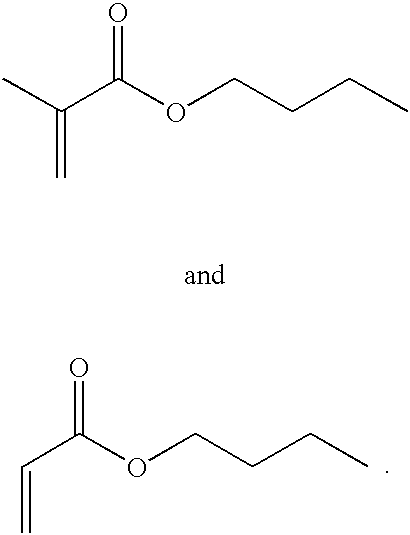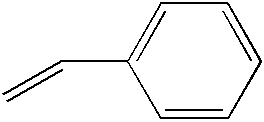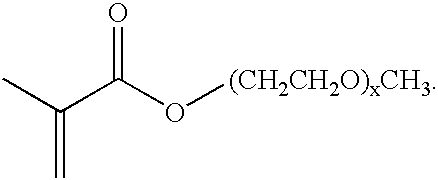Water-based acrylic emulsion dispersants utilized as grind resins for pigments and method of preparing the same
- Summary
- Abstract
- Description
- Claims
- Application Information
AI Technical Summary
Problems solved by technology
Method used
Image
Examples
example 1
[0058] The acrylic emulsion dispersant was prepared by adding and reacting the following parts, by weight, unless otherwise indicated.
1TABLE 1 Targeted Actual Amount Amount Reactant (moles) (grams) Other Butyl Methacrylate .692 99.3 --[BMA] Butyl Acrylate .690 88.7 --[BA] Styrene .560 56.3 --[MPEGMA] .027 9.4 -- [PEGMA] .278 102.2 Total Monomer Composi- tion equal to 355.9 grams (NH.sub.4).sub.2S.sub.2O.sub.8 N / A 1.16 0.3 wt. % of the Total [Initiator] Monomer Composition Anionic Surfactant N / A 22.7 -1.3 wt. % of the Total Monomer Composition -22.7 grams of a 20% aqueous soln. of the Anionic Surfactant (4.54 grams of Anionic Surfactant and 18.16 grams of H.sub.2O) Mercaptan N / A 7.5 2.0 wt. % of the Total Monomer Composition Water N / A 833.3 --[de-ionized water] TOTAL N / A 1220.56 -- Intermediate Emulsion Polymer is formed Polyphosphoric .095 47.2 47.2 grams of a 20% aque-Acid ous soln. of the Polyphos-phoric acid (10.1 grams H.sub.3PO.sub.4 and 37.1 grams H.sub.2O) Dimethylethanolamin...
example 2
[0062] The completed acrylic emulsion dispersant was then incorporated into a modified pigment dispersion according to the following table, Table 2.
2TABLE 2 Pigment Dispersion Component (modified) Amount (grams) Other ACRYLIC EMULSION DISPERSANT 211.0 --water 207.0 --[de-ionized water] co-solvent 48.0 --[propyl propasol] pigment 939.0 Added pigment gradually over [titanium dioxide, TiO.sub.2] time and under stirring defoaming additive 0.29 --Appearance Evaluation N / A Glossy appearance of modified pigment dispersion on a 2 mil thickness drawdown
[0063] Per the above table, Table 2, 211.0 grams of the acrylic emulsion dispersant and 207.0 grams of de-ionized water and 48.0 grams of propyl propasol and 0.29 grams of a defoaming additive were added together to prepare a modified pigment dispersion for an aqueous coating composition. Next, 939.0 grams of TiO.sub.2 pigment were added gradually over time and under stirring to the acrylic emulsion dispersant / the de-ionized water / propyl propa...
PUM
| Property | Measurement | Unit |
|---|---|---|
| Fraction | aaaaa | aaaaa |
| Percent by mass | aaaaa | aaaaa |
| Percent by mass | aaaaa | aaaaa |
Abstract
Description
Claims
Application Information
 Login to View More
Login to View More - R&D
- Intellectual Property
- Life Sciences
- Materials
- Tech Scout
- Unparalleled Data Quality
- Higher Quality Content
- 60% Fewer Hallucinations
Browse by: Latest US Patents, China's latest patents, Technical Efficacy Thesaurus, Application Domain, Technology Topic, Popular Technical Reports.
© 2025 PatSnap. All rights reserved.Legal|Privacy policy|Modern Slavery Act Transparency Statement|Sitemap|About US| Contact US: help@patsnap.com



